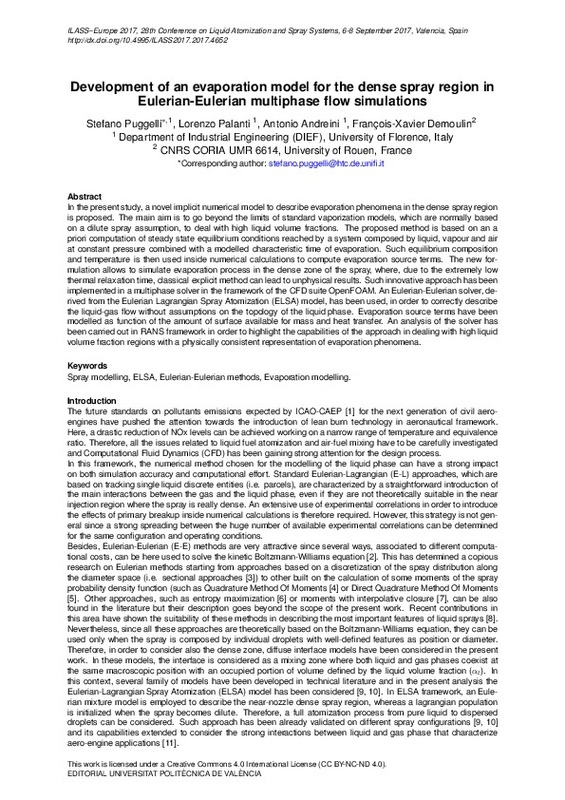JavaScript is disabled for your browser. Some features of this site may not work without it.
Buscar en RiuNet
Listar
Mi cuenta
Estadísticas
Ayuda RiuNet
Admin. UPV
Development of an evaporation model for the dense spray region in Eulerian-Eulerian multiphase flow simulations
Mostrar el registro sencillo del ítem
Ficheros en el ítem
| dc.contributor.author | Puggelli, Stefano
|
es_ES |
| dc.contributor.author | Palanti, Lorenzo
|
es_ES |
| dc.contributor.author | Andreini, Antonio
|
es_ES |
| dc.contributor.author | Demoulin, François-Xavier
|
es_ES |
| dc.date.accessioned | 2018-04-11T10:57:44Z | |
| dc.date.available | 2018-04-11T10:57:44Z | |
| dc.date.issued | 2017-07-28 | |
| dc.identifier.isbn | 9788490485804 | |
| dc.identifier.uri | http://hdl.handle.net/10251/100204 | |
| dc.description.abstract | [EN] In the present study, a novel implicit numerical model to describe evaporation phenomena in the dense spray region is proposed. The main aim is to go beyond the limits of standard vaporization models, which are normally based on a dilute spray assumption, to deal with high liquid volume fractions. The proposed method is based on an a priori computation of steady state equilibrium conditions reached by a system composed by liquid, vapour and air at constant pressure combined with a modelled characteristic time of evaporation. Such equilibrium composition and temperature is then used inside numerical calculations to compute evaporation source terms. The new formulation allows to simulate evaporation process in the dense zone of the spray, where, due to the extremely low thermal relaxation time, classical explicit method can lead to unphysical results. Such innovative approach has been implemented in a multiphase solver in the framework of the CFD suite OpenFOAM. An Eulerian-Eulerian solver, derived from the Eulerian Lagrangian Spray Atomization (ELSA) model, has been used, in order to correctly describe the liquid-gas flow without assumptions on the topology of the liquid phase. Evaporation source terms have been modelled as function of the amount of surface available for mass and heat transfer. An analysis of the solver has been carried out in RANS framework in order to highlight the capabilities of the approach in dealing with high liquid volume fraction regions with a physically consistent representation of evaporation phenomena. | es_ES |
| dc.format.extent | 10 | es_ES |
| dc.language | Inglés | es_ES |
| dc.publisher | Editorial Universitat Politècnica de València | es_ES |
| dc.relation.ispartof | Ilass Europe. 28th european conference on Liquid Atomization and Spray Systems | es_ES |
| dc.rights | Reconocimiento - No comercial - Sin obra derivada (by-nc-nd) | es_ES |
| dc.subject | Spray modelling | es_ES |
| dc.subject | ELSA | es_ES |
| dc.subject | Eulerian-Eulerian methods | es_ES |
| dc.subject | Evaporation modelling | es_ES |
| dc.title | Development of an evaporation model for the dense spray region in Eulerian-Eulerian multiphase flow simulations | es_ES |
| dc.type | Capítulo de libro | es_ES |
| dc.type | Comunicación en congreso | es_ES |
| dc.identifier.doi | 10.4995/ILASS2017.2017.4652 | |
| dc.rights.accessRights | Abierto | es_ES |
| dc.description.bibliographicCitation | Puggelli, S.; Palanti, L.; Andreini, A.; Demoulin, F. (2017). Development of an evaporation model for the dense spray region in Eulerian-Eulerian multiphase flow simulations. En Ilass Europe. 28th european conference on Liquid Atomization and Spray Systems. Editorial Universitat Politècnica de València. 929-938. https://doi.org/10.4995/ILASS2017.2017.4652 | es_ES |
| dc.description.accrualMethod | OCS | es_ES |
| dc.relation.conferencename | ILASS2017 - 28th European Conference on Liquid Atomization and Spray Systems | es_ES |
| dc.relation.conferencedate | September 06-08,2017 | es_ES |
| dc.relation.conferenceplace | Valencia, Spain | es_ES |
| dc.relation.publisherversion | http://ocs.editorial.upv.es/index.php/ILASS/ILASS2017/paper/view/4652 | es_ES |
| dc.description.upvformatpinicio | 929 | es_ES |
| dc.description.upvformatpfin | 938 | es_ES |
| dc.type.version | info:eu-repo/semantics/publishedVersion | es_ES |
| dc.relation.pasarela | OCS\4652 | es_ES |








